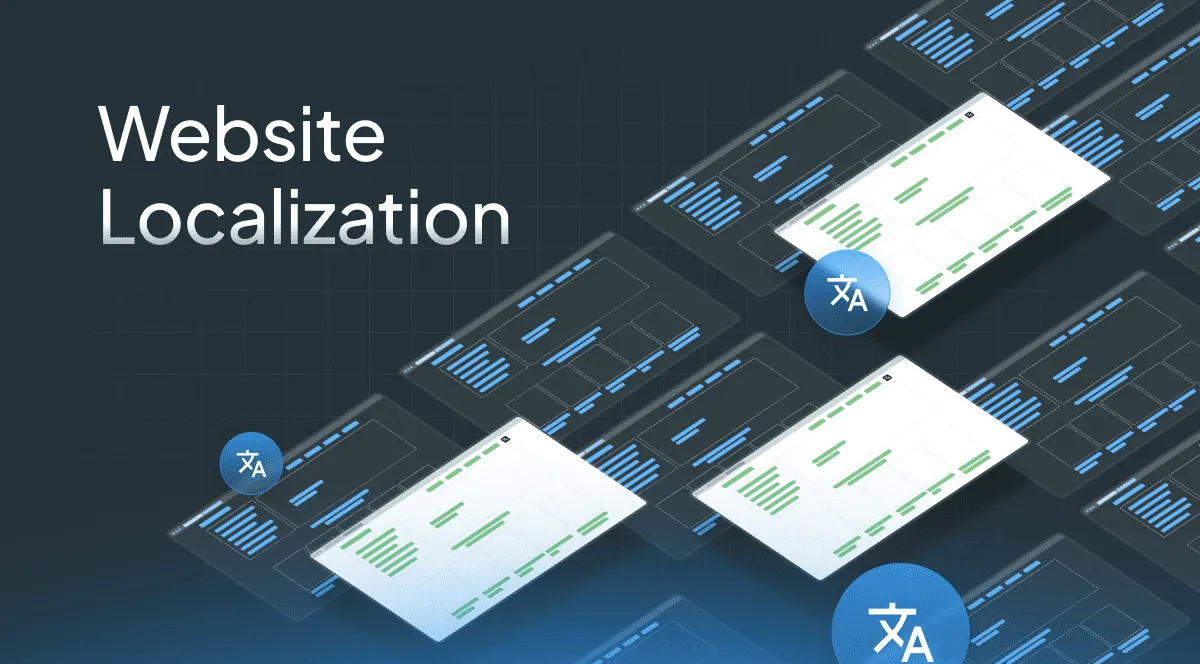More than half of the global online consumers tend to choose products based on the brand and how it communicates its values to the person. A successful business is not only one that provides quality but also speaks and relates to the customer. Both figuratively and literally.
So, how can you make sure your e-commerce message sounds right with people all over the world? The answer lies in website localization.
Website localization is a complex process. But it will help you expand globally as well as connect with the target region. This article will cover what website localization is, the benefits of the process, and provide a step-by-step guide on how to localize a website. Let’s get started!
Article Highlights:
- Website translation is only one of the processes included in website localization. Such a complex process that also requires adapting local content to align with cultures and preferences. This allows to meet user expectations, and to create an authentic user experience.
- Successful localization of web content enhances user engagement and conversion rates. This leads to increased trust and satisfaction among global audiences.
- Utilizing AI and effective localization tools simplifies the process. It enhances accuracy and enables continuous updates. This ensures ongoing relevance in diverse markets.
What Is Website Localization?
Website localization is the process of adapting a website to a specific market’s language and culture. Localization involves text translation and adaptation of currency, date formats, images, and payment options. The main goal is to provide the best user experience for each target market.

Language Translation as Part of Localization
Localization enables businesses to make their products more accessible and appealing to different regions. Providing options in multiple target languages is not enough. Your team must adapt the content to fit the cultural nuances of the local audiences. Localization covers:
- Digital assets
- Content
- Channels
- Social media posts
- SEO
- Legal and regulatory requirements
This approach impacts every aspect of the website, providing the best experience for users.
Language translation is a main part of localization. Providing content in different languages is important. It allows you to reach as many target audiences as possible. But site localization is a more complex multilevel process.
In summary, localization of websites is a powerful tool. It helps businesses connect with global audiences on a deeper level. Aligning with local cultural norms and preferences helps companies:
- Enhance user experience
- Boost engagement
- Drive growth
Localization vs. Translation vs. Internationalization
Translation focuses on converting text from one language to another. But localization involves adapting the entire user experience to meet cultural preferences and expectations, including cultural differences.
Internationalization is the process of designing an adaptable website for international customers. The result – a website that adjusts to various languages and regions with no major changes.
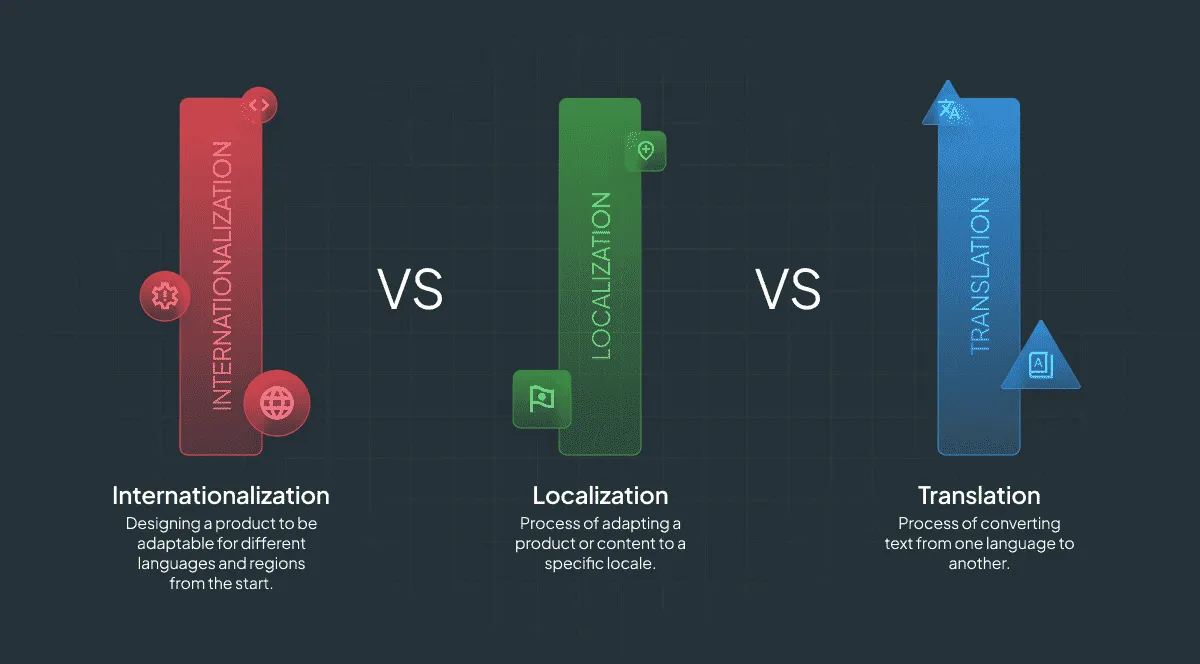
Effective website translation and localization is a blend:
Accurate translation + Engaging localization = User satisfaction
Be mindful of cultural details such as preferences and localized keywords. Neglecting them can compromise search engine optimization and brand integrity. Thus, a successful website localization strategy must consider the differences between translation, localization, and internationalization to create a culturally relevant experience for users.
Benefits of Website Localization
You might be wondering, “Why not just use Google Translate?”. We listed the main benefits of website localization that help businesses be successful in the local market. With business translation, companies can achieve improved UX and product appeal, and better SEO ranking.
Improved User Experience
Web localization improves the user interface experience. Tailoring website content to local preferences boosts user satisfaction and reduces abandonment rates. When users feel that a website speaks the same language and understands their context, they are more likely to engage and return.
By applying advanced website localization technology, businesses can:
- Simplify their workflows
- Provide consistency
- Ensure accuracy and cultural relevance.
This creates a better user experience. Additionally, this approach ensures a more effective interaction across global markets.
More Attractive Product Appeal
Localization also allows for tailored messaging that enhances product appeal in local markets. This can lead to higher conversion rates. Businesses can increase trust and comfort among local customers and international visitors. Which leads to higher conversion rates with a localized version of their content by:
- Offering region-specific preferred payment methods
- Incorporating local cultural nuances
- Adapting to local languages and the target region differences
Improved SEO Ranking
Moreover, web content localization can have a positive impact on multilingual search engine optimization. Businesses can drive more organic traffic by optimizing content for local search engines. This also enhances the effectiveness of marketing strategies.
Is It Time to Localize Your Website?
Determining the right time to localize your website is crucial for maximizing the impact of your efforts. Let’s go over the main signals:
- One clear indicator is when you start seeing a high volume of international traffic. If a large part of your website visitors are from foreign regions, it’s a strong signal. Localization could improve their experience and increase engagement.
- Another trigger is market saturation. Take notice if your target market is becoming saturated and growth has plateaued. In such cases, expanding into new markets through localization opens up new revenue streams.
- Competitor behavior - your direct competitors are going multilingual. It’s essential to keep up to maintain a competitive advantage.
- Frequent support requests from international users. It showcases the necessity of localized content to better serve your local and global audience.
- An adaptable product that transcends borders and has no profound connection to the place of production. For such companies, expanding to a foreign market will improve sales rates.
8 Steps to Localize a Website
Localizing an existing website involves several critical steps. This ensures the process is comprehensive and effective. Additionally, a localization solution can enhance this process.
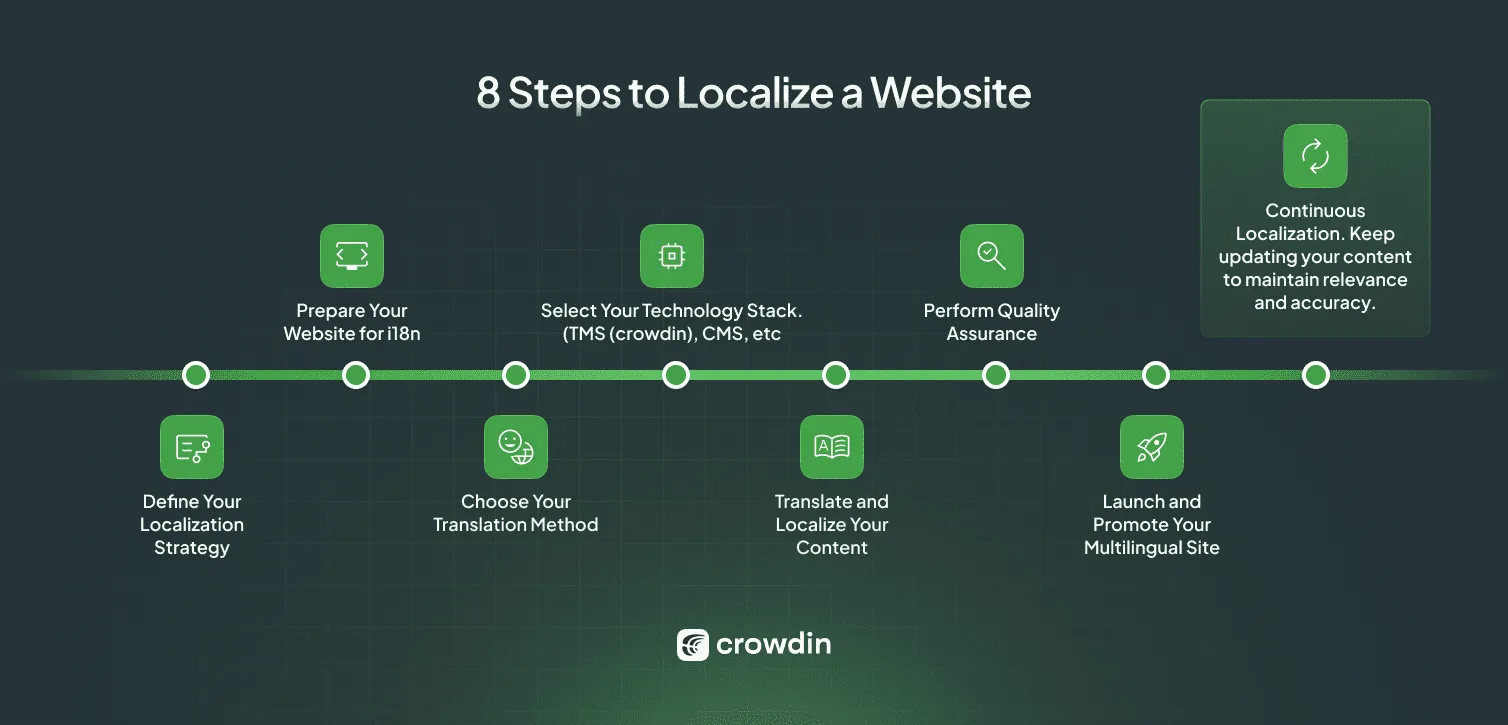
- Define Your Localization Strategy. Start by identifying your target markets. Rank content for prioritized localization.
- Prepare Your Website for Internationalization (i18n). Set up the technical foundation to support multiple languages and regional adaptations.
- Choose Your Translation Method:
- In-house translators
- Freelancers
- Language Service Providers (LSPs)
- Hybrid approach
- Select Your Technology Stack. Search for Translation Management Systems (TMS) and content management systems integrations
- Translate and Localize Your Content. This is where the actual translation and localization work happens. For e-commerce websites, this step also includes localizing product descriptions, payment methods, and customer service options. The method differs based on the technology used to build the site, such as WordPress or Next.js.
- Perform In-Depth Quality Assurance (QA). Conduct thorough testing to ensure translation accuracy and functionality.
- Launch and Promote Your Multilingual Site. Make sure to promote your localized website to the target audience to maximize its reach. Focus on SEO by adapting meta descriptions, titles, and keywords to rank well in local search engines.
- Continuous Localization. Keep updating your content to maintain relevance and accuracy.
Choosing the Right Localization Solutions
Utilizing a Translation Management System (TMS) is a must. It helps enhance collaboration and project management in website localization. AI-driven translation tools can further improve content management. They also automate various aspects of the localization.
Automation tools like Crowdin offer integrations with design and development software. This helps with simplifying the localization steps. Such tools also include QA checks to ensure the quality and consistency of translations. By selecting the right localization technology, businesses can overcome common challenges. Another benefit - enhancement of their localization workflows.
Creating a Localization Workflow
Two common approaches to localization workflows are the waterfall and continuous (agile) methods. The Waterfall approach is the more structured option with set deadlines and limited available changes on the way.
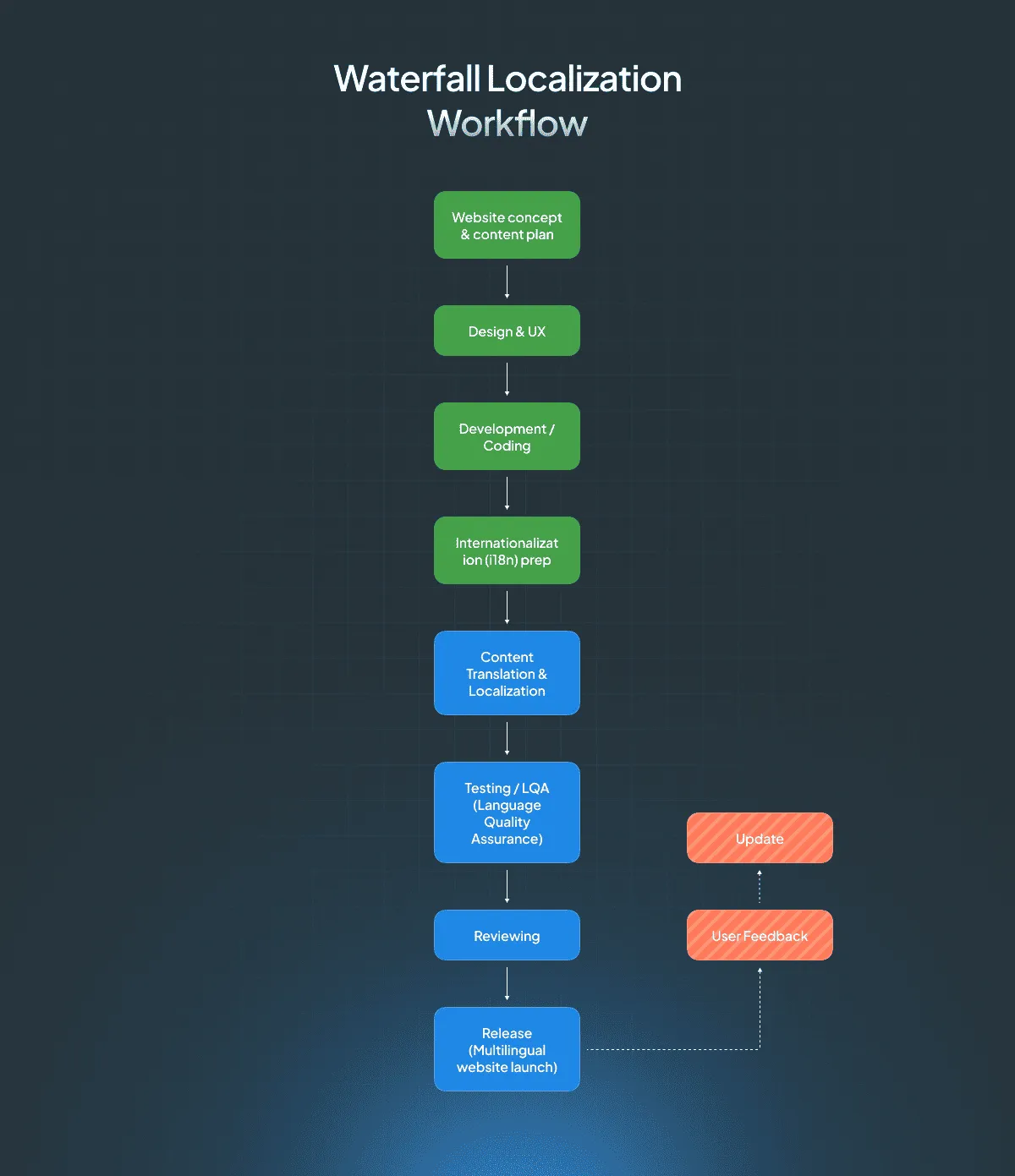
At the same time, the agile approach is best suited for constant ongoing updates; it is more of a continuous process rather than a set-and-done project.
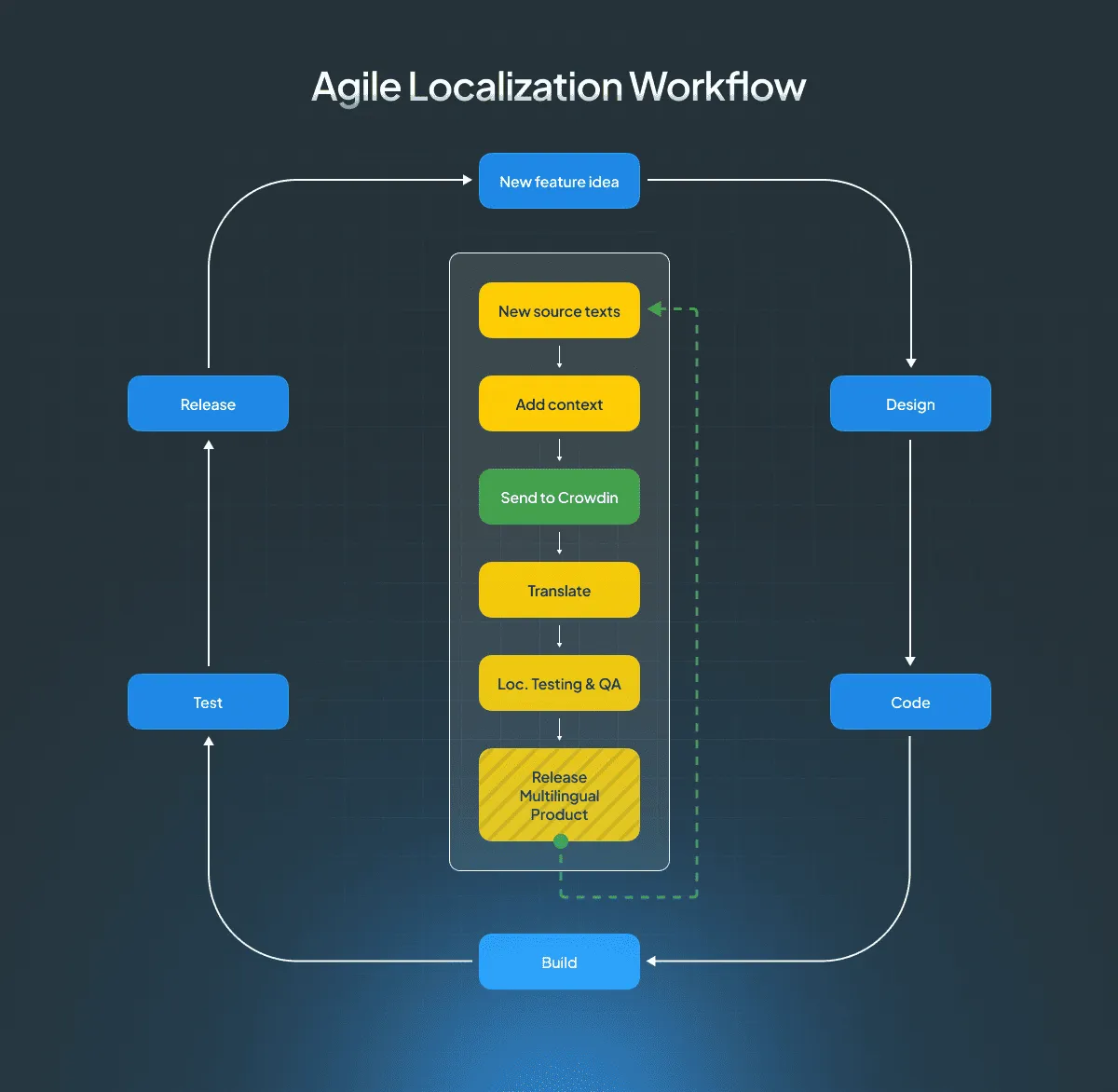
There are two website localization workflow parts: stakeholders and stages. No matter what approach you decide on, the stages of the workflow remain the same. The only difference is that the agile approach suggests a loop back to the start after QA. The main stages include:
Design (Figma) > Development (Git) > Content (CMS) > Translation (Crowdin) > QA > Launch
Successful website localization requires the involvement of several key stakeholders:
- Developers
- Product managers
- Copywriters
- Marketers
- Professional translators
- QA specialists
Collaboration among these team members is the foundation for a smooth and efficient localization workflow. It helps maintain high standards and helps avoid conflicts among stakeholders.
Each stage represents steps in the development of the concept to its realization:
- In design, you outline the goals and the final result
- In development, the team of developers makes the necessary website adjustments and so on.
Every stakeholder has its role in the dedicated stage. For example, copywriters in the translation stage, marketers in the content stage.
SEO and Keyword Research
Adding Hreflang tags is not enough for effective website localization. To optimize SEO for different regions and make the website visible to the local audiences, SEO localization is a must.
International URL Structures
There are 2 main international UPM structures: Subdomains and subdirectories. Let’s take a closer look at these terms:
- Subdomains are treated as separate websites by search engines. They allow strong regional targeting. Yet, at the same time, they need more SEO effort to build authority for each version.
- Subdirectories share domain authority with the leading site. This makes them easier to manage and often more efficient for SEO.
For most businesses, subdirectories tend to be a more considerate choice. This is because they consolidate SEO value and are easier to maintain. Subdomains are a more useful option for large enterprises with independent regional teams.
Managing Multilingual Sitemaps
Each translated version of the website must come with a separate XML sitemap. When creating the robots.txt file, remember to reference each sitemap. Include hreflang annotations within the sitemaps. It helps indicate language and regional targeting to search engines. This improves crawl efficiency and indexing.
Canonicalization & Duplicate Content
Without proper canonical tags, multilingual sites risk being flagged for duplicate content. This occurs when similar pages exist in multiple languages. Here are some tips to avoid duplication:
- Always set the canonical URL for each localized page.
- Ensure the canonical points to the correct version of the page (not just the original language).
- Pair canonicals with hreflang to help Google serve the correct version to the right audience.
Testing and Launching Your Localized Website
Testing is a major step in the localization process to ensure the functionality and effectiveness of adapted website content. Before launching a website adapted to the new markets, you must test every part. This includes checking for translation accuracy, UI functionality, and any technical issues.
Thorough testing not only helps identify and fix issues but also protects the brand’s reputation and ensures user satisfaction. Once testing is complete, the focus should shift to refining the localization and preparing for the launch.
Functional and Linguistic Testing
Functional testing verifies whether a localized interface accurately displays region-specific formats, such as dates and currencies. It also ensures that all proper website features work after localization.
Linguistic testing assesses if translations resonate with native speakers and adhere to cultural contexts. User testing, which involves observing real users as they interact with the localized content, provides valuable insights into usability and linguistic accuracy. This step is critical for ensuring both accuracy and usability of localized websites.
Make a Pre-Launch Checklist
A pre-launch checklist is important to ensure all adjusted website content meets quality and usability standards. This includes a final review of all localized content and conducting last-minute checks of functionality and cultural appropriateness.
Functional testing ensures that all features work as they should, while linguistic testing examines the accuracy and nuances of the local culture. Thorough testing before launch helps in identifying and fixing issues that could affect user satisfaction and website traffic.
Measuring Success and Optimizing
Measuring the success of your website localization strategy is necessary for ongoing optimization. Tracking metrics and key performance indicators (KPIs) helps assess how well localized content resonates with local customers. Regular evaluation of localized websites can help identify necessary improvements and updates.
An effective post-launch marketing strategy involves:
- Continuous monitoring
- Adaptation to enhance user engagement and satisfaction.
Ongoing updates are essential. They keep localized websites aligned with changing market trends and user expectations.
Key Metrics and KPIs
Tracking user behavior and engagement metrics provides valuable insights. They provide data on the effectiveness of localized content and include:
- Page views
- Click-through rates
- Conversion rates
Revenue from localized markets can also show the success of website localization. Increased sales always reflect positive results.
Customer satisfaction surveys in localized regions can provide critical feedback on the success of localization initiatives. By evaluating these metrics, businesses can assess the return on investment and make informed decisions for future strategies.
Continuous Improvement
User behavior changes over time. This is why content may need to be updated to provide a better experience. Try implementing feedback pop-ups and other contact forms. It ensures that recurring issues in localization are addressed and improved over time.
Gathering regular feedback from users helps:
- Identify specific localization issues that need addressing.
- Highlight areas for improvement in localized websites. It is done through regular analysis of metrics and user feedback.
- Ensure content remains relevant and competitive.
Localization Industry Best Practices
We have compiled a list of what to do and what not to do when adjusting your website to fit the local market. This will help you avoid common mistakes and implement beneficial processes.
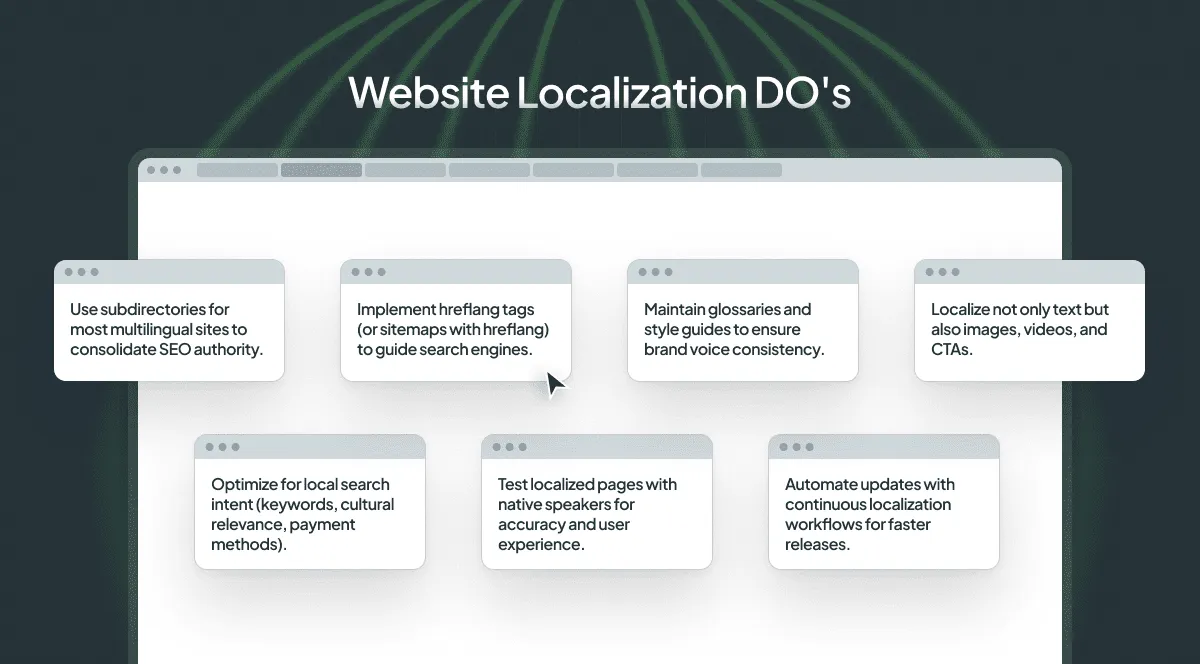
- Use subdirectories for most multilingual sites to consolidate SEO authority.
- Implement hreflang tags (or sitemaps with hreflang) to guide search engines.
- Maintain glossaries and style guides to ensure brand voice consistency.
- Localize not only text but also images, videos, and CTAs.
- Optimize for local search intent (keywords, cultural relevance, payment methods).
- Test localized pages with native speakers for accuracy and user experience.
- Automate updates with continuous localization workflows for faster releases.
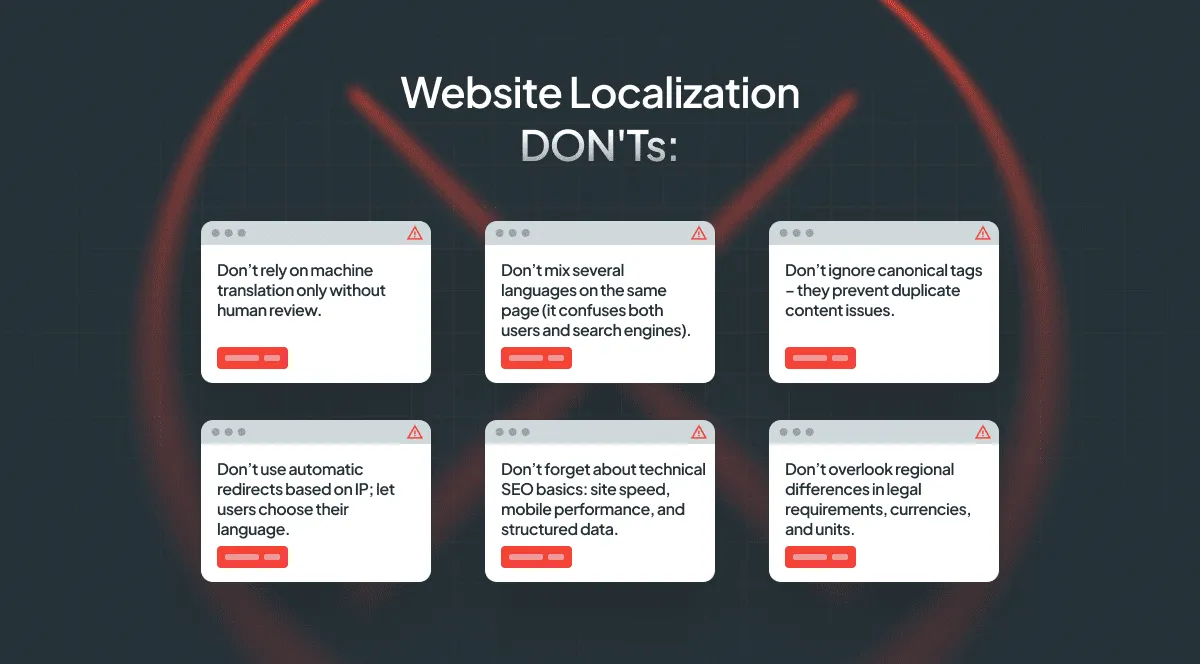
- Don’t rely on machine translation only without human review.
- Don’t mix several languages on the same page (it confuses both users and search engines).
- Don’t ignore canonical tags – they prevent duplicate content issues.
- Don’t use automatic redirects based on IP; let users choose their language.
- Don’t forget about technical SEO basics: site speed, mobile performance, and structured data.
- Don’t overlook regional differences in legal requirements, currencies, and units.
Budgeting for Localization and ROI Framework
Effective budgeting for localization is crucial. It ensures that businesses allocate adequate resources for website translation and new market content adaptation. A comprehensive assessment from the localization partner should include:
- Total costs associated with setup
- Maintenance
- Updates
- Ongoing optimization
This helps in making informed financial decisions. Such decisions ensure long-term success and sustainable growth in international markets.
Estimating Localization Costs
The cost of localizing a website can vary, considering the number of target languages and regions. Effective budgeting for localization encompasses various expenses that can impact translation costs. Using translation memory tools can help reduce costs. This is due to the reuse of previous translations, particularly for repetitive text.
Urgent localization projects tend to incur higher localization costs. This is because of the need for accelerated timelines. Additionally, design adjustments, such as layout modifications and image translations, are significant components of the localization budget.
Localization quality assurance (LQA) is essential to ensure functionality and accuracy after localization is completed.
Calculating ROI
Calculating ROI for localization efforts is essential. It provides an understanding of the effectiveness of the investment. Key metrics that illustrate the business impact of localization are:
- Increased localized traffic
- Higher conversion rates
- Improved user engagement
- Shorter buyer journeys
Using these metrics allows businesses to illustrate the return on investment. This makes a compelling case for the resources allocated to localization.
AI Revolution in Website Localization
Artificial Intelligence (AI) is revolutionizing the website localization industry by enabling:
- More efficient and accurate processes
- Optimized localization workflow
- Reduced turnaround times
- Improved consistency in translations
A great example is Crowdin’s AI translation tools. You can use these to create quality translations that are linked to your business requirements.
The ongoing development of AI technology suggests a different future. In the future, web localization will become even more effective, impacting global reach.
As AI continues to evolve, it promises to improve efficiency and translation accuracy. This will make localization more cost-effective and impactful.
AI-Powered Translation Tools
AI translation tools can provide real-time translation of the text, reducing the time needed for localization. These tools have revolutionized the translation landscape by:
- Automating processes that were once manual
- Enhancing the efficiency of machine translations
- Allowing companies to localize content more quickly through human translation.
Using AI-powered localization tools not only saves time. It also helps maintain consistency and accuracy in the translated content.
The main winners of this trend are businesses that adapt their content in multiple languages. Such a tendency ensures quick, accurate, and appropriate translations.
For example, Crowdin provides a suite of AI features for localization, integrating with 10+ top AI providers like OpenAI, Gemini, Claude, and Grok.
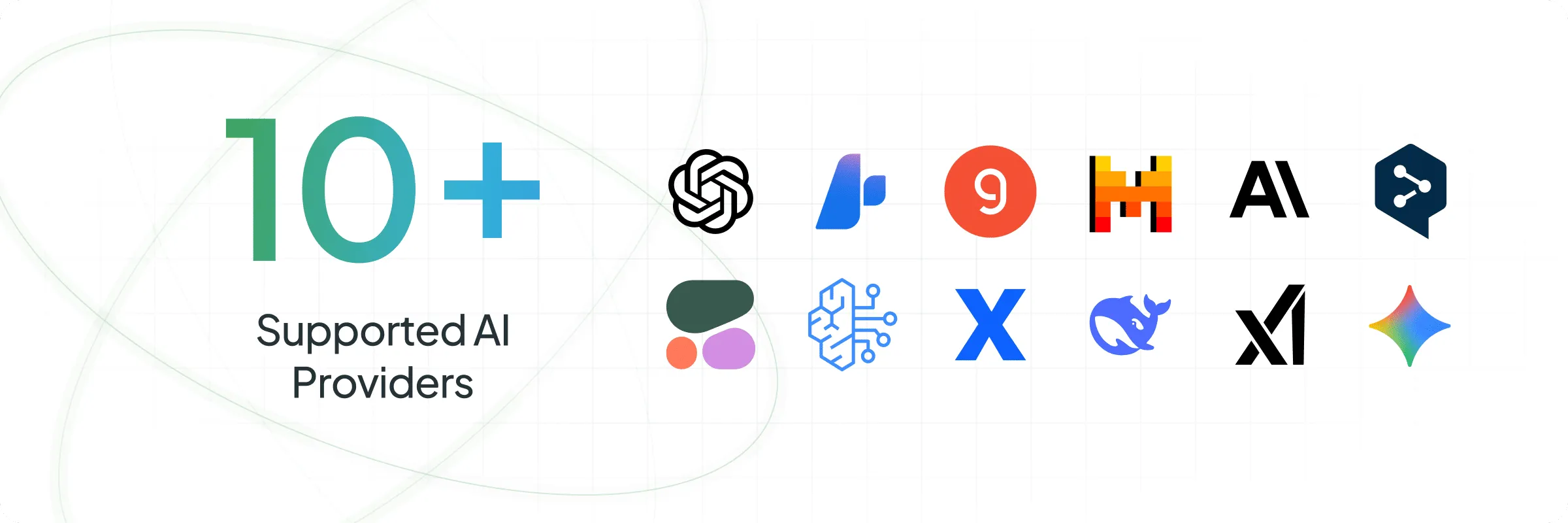
Crowdin’s AI tools include:
- Context Harvester: An AI tool that analyzes your codebase and project files to automatically find and provide context for translation keys. This helps both human and AI translators understand the intended meaning of a phrase.
- Agentic AI: A conversational AI assistant that can be instructed to perform complex tasks, such as adjusting the tone of multiple strings or fixing gender-neutral language issues.
- AI Pre-translation: An automated tool that uses AI to pre-populate translations for new content, drastically speeding up the initial localization process.
- Linguistic Quality Assurance (LQA): An AI-powered tool that automatically performs quality checks on translations, helping to catch errors and maintain consistency before human review.
Post-Launch Strategies
Continuous localization is key to updated information being displayed on localized websites by:
- Making immediate updates after new content is made
- Ensuring the relevancy and accuracy of the displayed data
- User engagement and satisfaction analytics for highlighting improvement areas
To keep localized content, it is essential to collect user feedback. Additionally, constant data monitoring allows you to keep high user satisfaction.
Monitoring User Feedback
Collecting customer feedback is necessary for improving user experience. It allows for accurate distribution of localization efforts and to locate shortcomings.
Collecting user insights through surveys can reveal satisfaction levels with the localized content. For example, localization allowed a SaaS provider to reduce churn rates and improve customer retention through tailored support and documentation.
Regular Updates and Maintenance
To keep up with the trends, all localized content should be monitored and timely updated. Additionally, review all written content to ensure appropriate language norms are in place and culturally relevant.
Regularly scheduled content reviews help ensure accuracy and relevance. It allows for minimizing the risk of outdated information.
Conclusion: Start Your Website Localization Today
Take your website language localization to the next level with Crowdin’s comprehensive localization management platform. Request a demo or start a free 14-day trial to experience the benefits of an advanced localization platform.
Crowdin’s tools are designed to help you manage translations and adapt your content to different markets effectively, positioning your brand to engage a global audience successfully.
Other useful resources to check out:
- JavaScript localization tutorial
- Astro.js website localization guide
- Next.js i18n
- Angular.js i18n and localization guide
- Node.js i18n and localization for developers
Localize your website with Crowdin
FAQ
What is website localization?
Website localization is the process of adapting a website to a specific target market’s language, cultural norms, and technical requirements. This goes beyond simple translation by tailoring every aspect of the site. This includes language, visuals, currency, and local references.
How do I know if it’s time to localize my website?
It’s time to localize your website if you:
- notice significant international traffic
- receive frequent support requests from users outside your country
What tools can help in the localization process?
Using tools like Translation Management Systems (TMS) and AI-driven platforms. Software such as Crowdin can enhance your process of localization. Embrace these resources to make your workflow smoother and more efficient.
How can I measure the success of my localization?
To measure the success of your localization efforts, focus on tracking:
- user engagement
- conversion rates
- customer satisfaction
- revenue from localized markets
By analyzing these metrics, you can assess the impact of your strategy and make informed improvements.
What are the benefits of using AI in website localization?
Using AI in website localization speeds up the process while ensuring consistency and accuracy in translations. This empowers you to focus on strategic initiatives that enhance your brand.
How can I use AI to translate my entire website accurately?
AI website translations are a great tool since you can translate large pieces of content into a local language within minutes. To ensure accurate translations, opt for localization platforms that have AI trained for these types of tasks. Another step is human post-editing. Such an approach ensures quick and nuanced website translation.
How can I ensure brand voice consistency across ten different languages?
To ensure brand voice consistency, your translation team should follow style guides and specific guidelines to gain an understanding of the company’s message. You can also use localization platforms like Crowdin. It allows for managing terminology and checking for potential inconsistencies.
Do I need to localize my website’s images and videos?
Of course! Website localization encompasses more than text translation. It is also the change of visuals and multimedia content.
How long does a typical website localization project take?
The duration of the project depends on several factors. The main ones are differences between the local and target markets, as well as the project’s scale. Waterfall workflow projects take from 3 weeks to several months. But agile workflows take much less time since changes are not as significant and are continuous.
What is the best website localization software for an enterprise?
There are many robust solutions available on the market. One of the best ones is Crowdin Enterprise, which provides such essential tools as:
- AI and human translation workflows
- Team collaboration
- Glossaries and style guides for brand consistency
- Automation for continuous website updates
Yuliia Makarenko
Yuliia Makarenko is a marketing specialist with over a decade of experience, and she’s all about creating content that readers will love. She’s a pro at using her skills in SEO, research, and data analysis to write useful content. When she’s not diving into content creation, you can find her reading a good thriller, practicing some yoga, or simply enjoying playtime with her little one.
